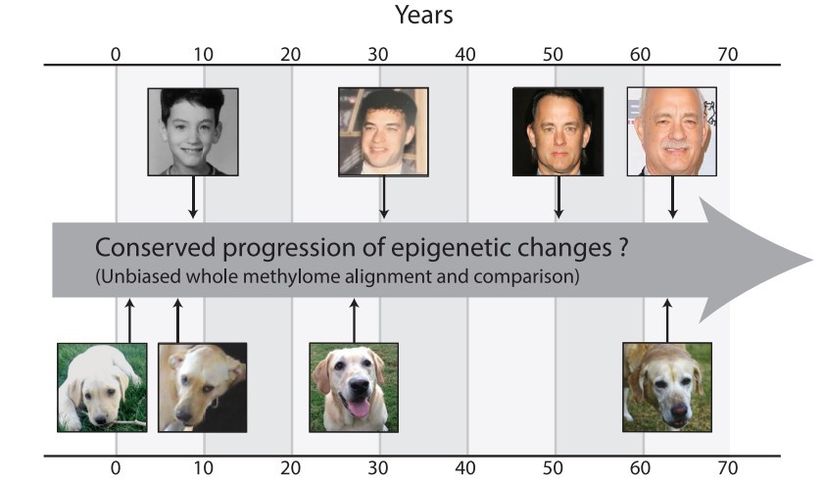How can you figure out how old your dog is? Multiplication by 7 is a thing of the past!

- Blog Yazısı
You're familiar with the age calculus for dogs: Multiply the number of years from a dog's birth by 7 to have the age that equivalent to its "human age." For instance, if your dog has been alive for four years, his age is (physiologically) similar to that of a 28-year-old person. A 10-year-old canine is about similar to a 70-year-old person.
This computation, however, is incorrect. It's because the ratio of a dog's aging rate to that of humans is assumed to remain constant in this computation. This is a flawed belief. When we examine the growth of dogs, we can find that they grow more quicker than people in the first several months and years. After that, the rate of growth begins to decelerate. As a result, the growth rates of a dog and a person are not linear. Rather, the following is the relationship:
 Cell Systems
Cell SystemsA 1-year-old dog is around the same age as a 31-year-old person, not a 7-year-old human, according to this graph. A 4-year-old dog, on the other hand, is the same age as a 53-year-old person, not a 28-year-old. With time, the 7 to 1 ratio emerges, and a 10-year-old canine will eventually reach the same age as a 68-year-old person. If you wish to turn this graph into a formula, you'll get something like this:
16 * ln (age of dog) +31
You may need to use a calculator to compute ln, which is the natural logarithm.
But, regardless of how you compute it, it makes a lot more sense than the 7:1 multiplication technique. A one-year-old dog can readily reproduce, but a seven-year-old dog cannot (if a 30-year-old human can). Similarly, humans do not always develop at the same rate as they become older; after puberty, their growth slows significantly. Dogs do not develop as quickly as they did when they were younger beyond a certain age. As a result, as seen in the graph above, a growth chart appears that develops swiftly at first but eventually slows. As a result, a dog:
- In humans, "childhood" is defined as being between the ages of one and twelve years. In dogs, "childhood" is defined as being between the ages of two and six months.
- In humans, adolescence is defined as being between the ages of 12 and 25, however in dogs, it is defined as being between the ages of 6 and 2. Development is finished at this point.
- Humans are classified as "adults" when they are 25-50 years old, whereas dogs are classified as "adults" when they are 2-7 years old.
- While people experience "old age" until they are 70 years old, dogs experience "senility" until they are 12 years old. This phase lasts till the person's death.
Researchers from the University of California, San Diego School of Medicine looked at methyl groups in the canine and human genomes and came up with these results. Some epigenetic alterations occur in the genomes of living organisms as they age. The rise in methyl groups is the first of them. As a result, we can assess a living thing's aging rate and more clearly discern distinct phases of development by looking at the methyl groups. Cross-species comparisons could also be feasible, as this comment illustrates!
This may be thought of as a "epigenetic clock" that can be employed in developmental biology research, similar to how there is a "molecular clock" in evolutionary biology research. Time, like the ticking of a clock, operates and exhibits its influence on our DNA as the methyl groups multiply. Scientists can identify how the physiology of a living entity evolves over time by looking at these remnants.
Of course, the aforementioned figures pertain to a certain breed of dog (in this case, labradors and other dogs of comparable size); with other dog breeds, these timeframes may vary depending on size. The epigenetic clock, on the other hand, provides a comparison for other kinds of this size.
Future study in this area may help us better understand the parallels and variations in aging processes between other animals and humans. And, who knows, perhaps it will allow us to take steps toward overcoming aging!
Resources and Further Reading
Evrim Ağacı'nın çalışmalarına Kreosus, Patreon veya YouTube üzerinden maddi destekte bulunarak hem Türkiye'de bilim anlatıcılığının gelişmesine katkı sağlayabilirsiniz, hem de site ve uygulamamızı reklamsız olarak deneyimleyebilirsiniz. Reklamsız deneyim, sitemizin/uygulamamızın çeşitli kısımlarda gösterilen Google reklamlarını ve destek çağrılarını görmediğiniz, %100 reklamsız ve çok daha temiz bir site deneyimi sunmaktadır.
KreosusKreosus'ta her 50₺'lik destek, 1 aylık reklamsız deneyime karşılık geliyor. Bu sayede, tek seferlik destekçilerimiz de, aylık destekçilerimiz de toplam destekleriyle doğru orantılı bir süre boyunca reklamsız deneyim elde edebiliyorlar.
Kreosus destekçilerimizin reklamsız deneyimi, destek olmaya başladıkları anda devreye girmektedir ve ek bir işleme gerek yoktur.
PatreonPatreon destekçilerimiz, destek miktarından bağımsız olarak, Evrim Ağacı'na destek oldukları süre boyunca reklamsız deneyime erişmeyi sürdürebiliyorlar.
Patreon destekçilerimizin Patreon ile ilişkili e-posta hesapları, Evrim Ağacı'ndaki üyelik e-postaları ile birebir aynı olmalıdır. Patreon destekçilerimizin reklamsız deneyiminin devreye girmesi 24 saat alabilmektedir.
YouTubeYouTube destekçilerimizin hepsi otomatik olarak reklamsız deneyime şimdilik erişemiyorlar ve şu anda, YouTube üzerinden her destek seviyesine reklamsız deneyim ayrıcalığını sunamamaktayız. YouTube Destek Sistemi üzerinde sunulan farklı seviyelerin açıklamalarını okuyarak, hangi ayrıcalıklara erişebileceğinizi öğrenebilirsiniz.
Eğer seçtiğiniz seviye reklamsız deneyim ayrıcalığı sunuyorsa, destek olduktan sonra YouTube tarafından gösterilecek olan bağlantıdaki formu doldurarak reklamsız deneyime erişebilirsiniz. YouTube destekçilerimizin reklamsız deneyiminin devreye girmesi, formu doldurduktan sonra 24-72 saat alabilmektedir.
Diğer PlatformlarBu 3 platform haricinde destek olan destekçilerimize ne yazık ki reklamsız deneyim ayrıcalığını sunamamaktayız. Destekleriniz sayesinde sistemlerimizi geliştirmeyi sürdürüyoruz ve umuyoruz bu ayrıcalıkları zamanla genişletebileceğiz.
Giriş yapmayı unutmayın!Reklamsız deneyim için, maddi desteğiniz ile ilişkilendirilmiş olan Evrim Ağacı hesabınıza üye girişi yapmanız gerekmektedir. Giriş yapmadığınız takdirde reklamları görmeye devam edeceksinizdir.
T. Wang. (2020). Quantitative Translation Of Dog-To-Human Aging By Conserved Remodeling Of The Dna Methylome. Cell Systems, sf: 1-10. | Archive Link
- 1
- 1
- 0
- 0
- 0
- 0
- 0
- 0
- 0
- 0
- 0
- 0
Evrim Ağacı'na her ay sadece 1 kahve ısmarlayarak destek olmak ister misiniz?
Şu iki siteden birini kullanarak şimdi destek olabilirsiniz:
kreosus.com/evrimagaci | patreon.com/evrimagaci
Çıktı Bilgisi: Bu sayfa, Evrim Ağacı yazdırma aracı kullanılarak 16/12/2025 07:38:33 tarihinde oluşturulmuştur. Evrim Ağacı'ndaki içeriklerin tamamı, birden fazla editör tarafından, durmaksızın elden geçirilmekte, güncellenmekte ve geliştirilmektedir. Dolayısıyla bu çıktının alındığı tarihten sonra yapılan güncellemeleri görmek ve bu içeriğin en güncel halini okumak için lütfen şu adrese gidiniz: https://evrimagaci.org/s/11496
İçerik Kullanım İzinleri: Evrim Ağacı'ndaki yazılı içerikler orijinallerine hiçbir şekilde dokunulmadığı müddetçe izin alınmaksızın paylaşılabilir, kopyalanabilir, yapıştırılabilir, çoğaltılabilir, basılabilir, dağıtılabilir, yayılabilir, alıntılanabilir. Ancak bu içeriklerin hiçbiri izin alınmaksızın değiştirilemez ve değiştirilmiş halleri Evrim Ağacı'na aitmiş gibi sunulamaz. Benzer şekilde, içeriklerin hiçbiri, söz konusu içeriğin açıkça belirtilmiş yazarlarından ve Evrim Ağacı'ndan başkasına aitmiş gibi sunulamaz. Bu sayfa izin alınmaksızın düzenlenemez, Evrim Ağacı logosu, yazar/editör bilgileri ve içeriğin diğer kısımları izin alınmaksızın değiştirilemez veya kaldırılamaz.








